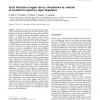Free Online Productivity Tools
i2Speak
i2Symbol
i2OCR
iTex2Img
iWeb2Print
iWeb2Shot
i2Type
iPdf2Split
iPdf2Merge
i2Bopomofo
i2Arabic
i2Style
i2Image
i2PDF
iLatex2Rtf
Sci2ools
BC
1999
1999
Early detection of upper airway obstructions by analysis of acoustical respiratory input impedance
Repetitive occurrence of partial or total upper airway obstruction characterizes several respiratory dysfunctions such as the obstructive sleep apnea syndrome (OSAS). In OSAS patients, pharyngeal collapses are linked to a decrease in upper airway muscle activity during sleep which causes decreased upper airway wall stiness. Continuous positive airway pressure (CPAP) is recommended as the treatment of choice. Advancements in CPAP therapy require early detection of respiratory events in real time to adapt the level of the applied pressure to airway collapsibility. The forced oscillation technique (FOT) is a noninvasive method which re
| Added | 22 Dec 2010 |
| Updated | 22 Dec 2010 |
| Type | Journal |
| Year | 1999 |
| Where | BC |
| Authors | S. Reisch, Holger Steltner, Jens Timmer, C. Renotte, Josef Guttmann |
Comments (0)

